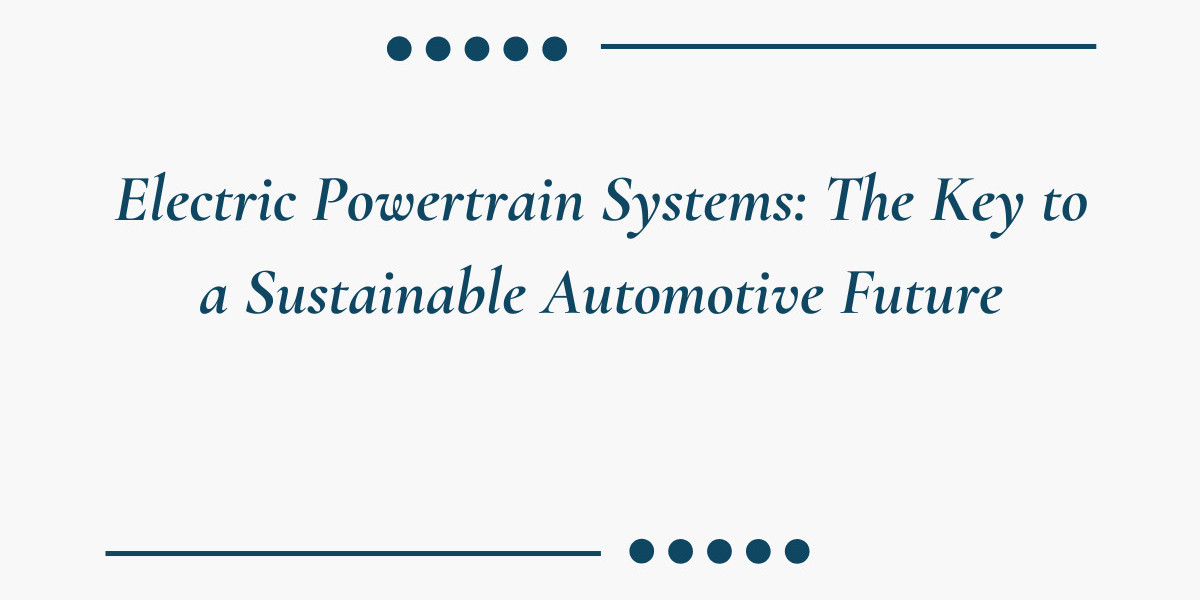Electric Powertrain Systems: The Future of Automotive Innovation
Introduction
The transition from traditional internal combustion engines to electric powertrain systems is reshaping the automotive industry. As concerns over carbon emissions, fuel dependency, and environmental impact continue to grow, automakers are investing heavily in electrification. The electric powertrain is at the heart of this transformation, offering a cleaner and more efficient alternative to conventional engines. With advancements in battery technology, motor efficiency, and energy management, electric vehicles are becoming increasingly viable for mainstream adoption.
An electric powertrain system consists of several key components that work together to convert electrical energy into mechanical motion. Unlike gasoline engines, which rely on combustion and multiple mechanical processes, electric powertrains provide instant torque and smooth acceleration. The core elements of an electric powertrain include the electric motor, battery pack, power electronics, and transmission system. Each component plays a crucial role in determining the overall efficiency and performance of an electric vehicle.
Components of an Electric Powertrain System
At the core of every electric powertrain is the electric motor, responsible for converting electrical energy into mechanical power. These motors operate on the principle of electromagnetic induction, producing rotational force to drive the wheels. Permanent magnet synchronous motors (PMSM) and induction motors are the two most common types used in EVs, each offering unique efficiency and power characteristics. The elimination of complex mechanical components found in internal combustion engines enhances reliability and reduces maintenance costs.
The battery pack is another critical component, serving as the primary energy source for the electric motor. Lithium-ion batteries dominate the EV market due to their high energy density, long lifespan, and rapid charging capabilities. As battery technology evolves, solid-state batteries and other advanced chemistries are expected to further improve energy storage and efficiency. The performance of an electric vehicle is directly linked to its battery capacity, determining the range and power output.
Power electronics act as the control center of the electric powertrain, regulating the flow of electricity between the battery and motor. The inverter plays a key role by converting direct current (DC) from the battery into alternating current (AC) required by the motor. Additionally, power electronics manage regenerative braking systems, enabling energy recovery during deceleration and increasing overall efficiency. Smart energy management systems optimize power distribution, ensuring that the vehicle operates at peak efficiency under different driving conditions.
Unlike traditional cars that rely on multi-gear transmissions, electric vehicles often use a single-speed gearbox. The direct torque delivery of electric motors eliminates the need for complex transmission systems, enhancing simplicity and reducing energy losses. Some high-performance EVs incorporate multi-speed gearboxes to optimize efficiency and acceleration at varying speeds. The design of the transmission system in an electric powertrain is focused on maintaining a seamless and responsive driving experience.
Advantages of Electric Powertrain Systems
The shift toward electric powertrains brings several advantages, making EVs an attractive alternative to traditional vehicles. One of the most significant benefits is energy efficiency. Electric motors convert over 90% of the stored energy into motion, far surpassing the efficiency of internal combustion engines, which waste a considerable portion of fuel as heat. This translates to lower energy consumption and reduced operating costs for EV owners.
Environmental sustainability is another key factor driving the adoption of electric powertrains. With zero tailpipe emissions, EVs contribute to cleaner air and reduced greenhouse gas emissions. As the energy grid transitions toward renewable sources, the overall carbon footprint of electric vehicles will continue to decrease. Governments worldwide are implementing policies and incentives to accelerate the transition to electrification, reinforcing the long-term viability of electric powertrains.
The driving experience in an electric vehicle is notably different from that of a gasoline-powered car. The absence of engine vibrations and noise results in a quieter and smoother ride. Instant torque delivery enables rapid acceleration, enhancing responsiveness and driving pleasure. The simplified design of electric powertrains reduces the number of moving parts, leading to lower maintenance requirements and increased reliability over time.
Challenges in Electric Powertrain Development
Despite their advantages, electric powertrain systems face several challenges that must be addressed to achieve widespread adoption. Battery technology remains one of the biggest obstacles, as energy storage capacity directly affects vehicle range. While lithium-ion batteries have seen significant improvements, limitations in energy density and charging speed persist. Ongoing research is focused on developing next-generation batteries that offer higher efficiency, faster charging, and longer lifespan.
Charging infrastructure is another critical challenge. The convenience of refueling gasoline-powered vehicles is not yet fully replicated by EV charging networks. Expanding fast-charging stations and improving charging speeds are essential to making EVs more practical for long-distance travel. Wireless charging and bidirectional charging innovations are also being explored to enhance the usability of electric powertrains.
Cost is another factor influencing the adoption of electric powertrain systems. Although battery prices have declined in recent years, EVs still tend to be more expensive than their gasoline counterparts. Economies of scale, advancements in battery production, and government incentives are helping to reduce costs, making electric vehicles more accessible to a broader audience.
Recycling and sustainability of battery materials pose additional challenges. The extraction of lithium, cobalt, and other rare elements used in EV batteries raises environmental and ethical concerns. Developing efficient battery recycling methods and alternative materials is crucial to ensuring a sustainable supply chain for electric powertrains. Automakers and researchers are exploring ways to create more eco-friendly battery technologies while minimizing environmental impact.
Future of Electric Powertrain Technology
The future of electric powertrain systems is marked by continuous innovation and advancements in efficiency, performance, and sustainability. Solid-state batteries are expected to revolutionize the industry by offering higher energy density, improved safety, and faster charging times. Automakers are investing heavily in research and development to bring these next-generation batteries to the market within the next decade.
Integration with renewable energy sources is another promising development. Smart grid technology and vehicle-to-grid (V2G) systems allow EVs to interact with the energy grid, providing storage solutions and balancing electricity demand. This synergy between electric vehicles and sustainable energy sources has the potential to create a more resilient and efficient energy ecosystem.
Autonomous driving and artificial intelligence are also influencing the evolution of electric powertrains. Advanced driver-assistance systems (ADAS) and self-driving technologies are being integrated into EVs, enhancing safety and driving efficiency. Machine learning algorithms optimize energy consumption, adjusting power delivery based on driving patterns and road conditions. The combination of electrification and automation is shaping the next generation of intelligent and connected vehicles.
Wireless charging technology is gaining traction, with the potential to eliminate the need for plug-in chargers. Inductive charging pads embedded in roads and parking spaces enable seamless energy transfer, improving convenience and accessibility. As charging technology advances, range anxiety will become a thing of the past, further accelerating the transition to electric mobility.
FAQs
How does an electric powertrain differ from a traditional engine?
An electric powertrain relies on an electric motor and battery instead of a gasoline engine. It provides instant torque, higher efficiency, and lower maintenance costs.
What are the main components of an electric powertrain?
The main components include the electric motor, battery pack, power electronics, and transmission system. These work together to convert electrical energy into motion.
Are electric powertrains more efficient than gasoline engines?
Yes, electric powertrains convert over 90% of energy into motion, while gasoline engines waste a significant portion as heat, making EVs more energy-efficient.
What is regenerative braking in an electric powertrain?
Regenerative braking captures energy during deceleration and converts it into electricity, which is then stored in the battery to improve efficiency.
What is the future of electric powertrain technology?
The future includes advancements in solid-state batteries, wireless charging, smart grid integration, and autonomous driving, making EVs more efficient and sustainable.








